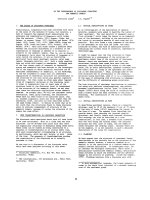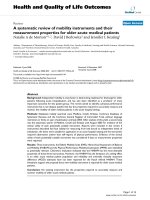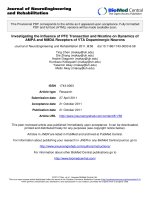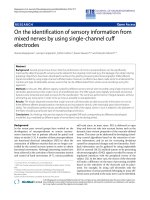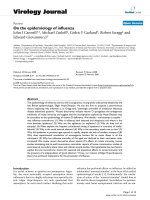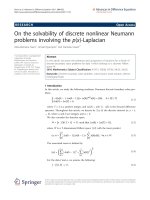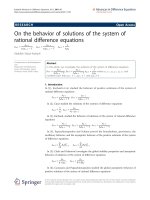Báo cáo hóa học: " ON THE BOUNDEDNESS OF MAXIMAL OPERATORS AND SINGULAR OPERATORS WITH KERNELS IN L(logL)α (Sn−1 )" doc
Bạn đang xem bản rút gọn của tài liệu. Xem và tải ngay bản đầy đủ của tài liệu tại đây (595.54 KB, 16 trang )
ON THE BOUNDEDNESS OF MAXIMAL OPERATORS AND
SINGULAR OPERATORS WITH KERNELS IN L(logL)
α
(S
n−1
)
H. M. AL-QASSEM
Received 15 November 2005; Revised 20 May 2006; Accepted 28 May 2006
We establish the L
p
-boundedness for a class of singular integral operators and a class
of related maximal operators when their singular kernels are given by functions Ω in
L(logL)
α
(S
n−1
).
Copyright © 2006 H. M. Al-Qassem. This is an open access article distributed under the
Creative Commons Attribution License, which permits unrestricted use, distribution,
and reproduction in any medium, provided the original work is properly cited.
1. Introduction
Throughout this paper, we let x
denote x/|x| for x ∈ R
n
\{0} and let p
denote the con-
jugate index of p; that is, 1/p+1/p
= 1. Also, we let R
n
, n ≥ 2, denote the n-dimensional
Euclidean space and let S
n−1
denote the unit sphere in R
n
equipped with the normalized
Lebesgue measure dσ
= dσ(·).
Let Γ
φ
={(y,φ(|y|)) : y ∈ R
n
} be the surface of revolution generated by a suitable
function φ :[0,
∞) → R.LetK
Ω,h
(y)beaCalder
´
on-Zygmund-type kernel of the form
K
Ω,h
(y) = h
|
y|
Ω(y
)|y|
−n
, (1.1)
where h :[0,
∞) → C is a measurable function, and Ω is an integrable function over S
n−1
,
satisfying
S
n−1
Ω(u)dσ(u) = 0. (1.2)
Let L(logL)
α
(S
n−1
)(forα>0) denote the space of all those measurable functions Ω on
S
n−1
which satisfy
Ω
L(logL)
α
(S
n−1
)
=
S
n−1
Ω(y)
log
α
2+
Ω(y)
dσ(y) < ∞. (1.3)
Hindawi Publishing Corporation
Journal of Inequalities and Applications
Volume 2006, Article ID 96732, Pages 1–16
DOI 10.1155/JIA/2006/96732
2 Boundedness of maximal and singular operators
For γ>1, define Δ
γ
(R
+
) to b e the set of all measurable functions h on R
+
satisfying the
condition
sup
R>0
R
−1
R
0
h(t)
γ
dt
1/γ
< ∞ (1.4)
and define Δ
∞
(R
+
) = L
∞
(R
+
). Also, for γ ≥ 1, define Ᏼ
γ
(R
+
) to be the set of al l measur-
able functions h on
R
+
satisfying the condition h
L
γ
(R
+
,dr/r)
= (
R
+
|h(r)|
γ
dr/r)
1/γ
≤ 1
and define Ᏼ
∞
(R
+
) = L
∞
(R
+
,dt/t).
We remark at this point that Δ
∞
(R
+
) Δ
γ
2
(R
+
) Δ
γ
1
(R
+
)forγ
1
<γ
2
, Ᏼ
∞
(R
+
) =
Δ
∞
(R
+
), and Ᏼ
γ
(R
+
) Δ
γ
(R
+
)for1<γ<∞.
The purpose of this paper is to study the L
p
mapping properties of singular integral
operators T
φ,Ω,h
in R
n
along the surface of revolution Γ
φ
defined for (x,x
n+1
) ∈ R
n
× R
=
R
n+1
by
T
φ,Ω,h
f
x, x
n+1
=
p.v.
R
n
f
x − y,x
n+1
− φ
|
y|
K
Ω,h
(y)dy. (1.5)
Also, we are interested in studying the L
p
-boundedness of the related maximal operator
(γ)
φ,Ω
given by
(γ)
φ,Ω
f
x, x
n+1
=
sup
h∈Ᏼ
γ
(R
+
)
T
φ,Ω,h
f
x, x
n+1
. (1.6)
Whenever φ(t)
≡ 0andh ≡ 1, then T
φ,Ω,h
essentially is the classical Calder
´
on-Zygmund
singular integral operator T
Ω
given by
T
Ω
f (x) = p.v.
R
n
f (x − y)Ω(y
)|y|
−n
dy. (1.7)
If φ(t)
≡ 0, we will denote T
φ,Ω,h
by T
Ω,h
and
(γ)
φ,Ω
by
(γ)
Ω
.
The investigation of the L
p
-boundedness problem of the operator T
Ω
began with
Calder
´
on and Zygmund in their well-known papers [7, 8]. The operator T
φ,Ω,h
, whose
singular kernel has the additional roughness in the radial direction due to the presence
of h, was first studied by Fefferman [17] and subsequently by other several well-known
authors. For a sampling of past studies, see [2, 4, 9, 13, 15, 20]. We will content ourselves
here with recalling only the following pertinent results.
In their celebrated paper [8], Calder
´
on and Zygmund showed that the L
p
-boundedness
of T
Ω
holds for 1 <p<∞ if Ω ∈ LlogL(S
n−1
). Moreover, the condition Ω ∈ LlogL(S
n−1
)
turns out to be the most desirable size condition for the L
p
-boundedness of T
Ω
. This
was made clear by Calder
´
on and Zygmund where it was shown that T
Ω
may fail to be
bounded on L
p
for any p if the condition Ω ∈ LlogL(S
n−1
)isreplacedbyanyweaker
metric condition Ω
∈ L
ϕ
(S
n−1
)withaϕ satisfying ϕ(t) = o(t logt)ast →∞(e.g., ϕ(t) =
L(logL)
1−ε
(S
n−1
), 0 <ε<1) (see [8]).
H. M. Al-Qassem 3
Kim et al. [18]studiedtheL
p
-boundedness of T
φ,Ω,h
as described in the following
theorem.
Theorem 1.1. Let T
φ,Ω,h
begivenasin(1.5)andh ≡ 1. Assume that Ω ∈ C
∞
(S
n−1
) and
satisfies (1.2). Assume also that φ(
·) is in C
2
of [0,∞), convex, and increasing. Then T
φ,Ω,1
is bounded on L
p
(R
n+1
) for 1 <p<∞.
Even though the authors of [18] imposed the condition Ω
∈ C
∞
(S
n−1
)inTheorem
1.1, the arguments employed in [18] can be modified to show that the conclusion in
Theorem 1.1 remains valid when one weakens the condition on Ω from Ω
∈ C
∞
(S
n−1
)to
Ω
∈ L
q
(S
n−1
)forsomeq>1.
An improvement and extension over the above result was obtained by Al-Salman and
Panin[4], where the condition Ω
∈ L
q
(S
n−1
) is replaced by the weaker condition Ω ∈
LlogL(S
n−1
). In fact, they proved the following.
Theorem 1.2. Let φ be a C
2
, convex, and increasing function satisfying φ(0) = 0 .IfΩ ∈
LlogL(S
n−1
) and h ∈ Δ
γ
(R
+
) for some γ>1, then the operator T
φ,Ω,h
in (1.2)–(1.5)is
bounded on L
p
(R
n+1
) for |1/p− 1/2| < min{1/γ
,1/2}.
We remark that the range of p given in Theorem 1.2 is the full range (1,
∞)when-
ever γ
≥ 2. However, this range of p becomes a tiny open interval around 2 as γ ap-
proaches 1. For L
p
-boundedness results on singular integrals for p satisfy ing |1/p− 1/2| <
min
{1/γ
,1/2},wereferthereadersto[2–4, 14, 15], among others. So,anunsolvedprob-
lem is whether the L
p
-boundedness of T
φ,Ω,h
holds for p outside this range.
The main focus of this paper is to have a solution to the above problem. In fact, we have
made some progress in resolving this problem by imposing a more restrictive condition
on h. However, the price we paid in having a more restricted condition on h is compen-
sated by the fact that we are able to prove our results under a much weaker condition on
Ω. More precisely we prove the following.
Theorem 1.3. Let T
φ,Ω,h
be given as in (1.2)–(1.5)andletφ be a C
2
, convex, and in-
creasing function satisfying φ(0)
= 0.Supposethath ∈ Ᏼ
γ
(R
+
) for some 1 <γ≤∞and
Ω
∈ L(logL)
1/γ
(S
n−1
). Then T
φ,Ω,h
is bounded on L
p
(R
n
) for 1 <p<∞.
At this point, it is worth mentioning that the proof of Theorem 1.3 cannot be obtained
by a simple application of existing arguments on singular integrals. Even though we have
a more restrictive condition on h, if we try to apply previously known arguments, t hen
we can prove our result only for p satisfying
|1/p− 1/2| < min{1/γ
,1/2}.Tobeable
to obtain the L
p
-boundedness for the full range 1 <p<∞, a new maximal function that
intervenes here in the proof of Theorem 1.3 is the maximal operator
(γ)
φ,Ω
defined in (1.6).
The study of the maximal operator
(γ)
φ,Ω
beganbyChenandLinin[10] and subsequently
by many other authors [1, 12, 19]. For example, Chen and Lin proved the following .
Theorem 1.4 [10]. Assume n
≥ 2, 1 ≤ γ ≤ 2,andΩ ∈ C(S
n−1
) satisfying (1.2). Then
(γ)
Ω
is bounded on L
p
(R
n
) for (γn)
<p<∞. Moreover, the range of p is the best possible.
Very recently, Al-Qassem improved the result in Theorem 1.4 as described in the fol-
lowing theorem.
4 Boundedness of maximal and singular operators
Theorem 1.5 [1]. Let n
≥ 2 and let
(γ)
Ω
begivenasin(1.6). Then
(a) if Ω
∈ L(logL)
1/γ
(S
n−1
) and satisfies (1.2), then
(γ)
Ω
is bounded on L
p
(R
n
) for γ
≤
p<∞;
(b) there exists an Ω which lies in L(logL)
1/2−ε
(S
n−1
) for all ε>0 and satisfies (1.2)such
that
(2)
Ω
is not bounded on L
2
(R
n
).
Our result regarding
(γ)
φ,Ω
is the following.
Theorem 1.6. Let
(γ)
φ,Ω
be given as in (1.6)andletφ be a C
2
, convex and increasing function
satisfying φ(0)
= 0.SupposeΩ ∈ L(logL)
1/γ
(S
n−1
) and satisfies (1.2). Then
(γ)
φ,Ω
is bounded
on L
p
(R
n
) for γ
≤ p<∞ and 1 <γ≤ 2, and it is bounded on L
∞
(R
n
) for γ = 1.
Remarks 1.7. (1) In order to clarify the relations between Theorems 1.1, 1.2, 1.4,and
1.5 and theorems 1.3 and 1.6, we remark that on the unit sphere S
n−1
,foranyq>1, the
following proper inclusions relations hold:
L
q
S
n−1
⊂
L(logL)
S
n−1
⊂
H
1
S
n−1
⊂
L
1
S
n−1
,
L(logL)
β
S
n−1
⊂
L(logL)
α
S
n−1
if 0 <α<β,
L(logL)
α
S
n−1
⊂
H
1
S
n−1
∀
α ≥ 1,
(1.8)
while
L(logL)
α
S
n−1
H
1
S
n−1
L(logL)
α
S
n−1
∀
0 <α<1.
(1.9)
Here H
1
(S
n−1
) is the Hardy space on the unit sphere in the sense of Coifman and Weiss
[11].
(2) For the case h
∈ Ᏼ
∞
(R
+
) = L
∞
(R
+
), the authors in [5] showed that there is a
function f ∈ L
p
such that the maximal operator acting on f (i.e.,
(∞)
Ω
( f )) yields an
identically infinite function. It is still an open question whether the L
p
-boundedness
of
(γ)
Ω
holds for 2 <γ<∞. A point worth noting is that Theorem 1.3 implies the L
p
-
boundedness of T
φ,Ω,h
if h ∈ Ᏼ
γ
(R
+
)forall1<γ≤∞.
(3) We notice that the singular integral operators T
Ω,h
are bounded on L
p
if Ω ∈
L(logL)
1/γ
(S
n−1
)andh ∈ Ᏼ
γ
(R
+
)forsomeγ>1, while the classical Calder
´
on-Zygmund
singular integral operator T
Ω
= T
Ω,1
is bounded on L
p
if Ω ∈ L(log L)(S
n−1
). The reason
for this new phenomenon on singular integrals is that the singular operators T
Ω,h
(with
h
∈ Ᏼ
γ
(R
+
)forsome1<γ<∞) have weaker singularities than the singular operators
T
Ω,1
due to the presence of the strong condition on h.
(4) We notice that Theorem 1.6 represents an improvement and extension over the
result in Theorem 1.4 and it is a n extension over Theorem 1.5. Also, since Llog L(S
n−1
) ⊂
L(logL)
1/γ
(S
n−1
)foranyγ>1, Theorem 1.3 represents an improvement over Theorem
1.2 in the case h
∈ Ᏼ
γ
(R
+
)forsome1<γ<∞.
(5) The method employed in this paper is based in part on a combination of ideas and
arguments from [2, 13, 15, 16, 19], among others.
Throughout the rest of the paper, the letter C will stand for a constant but not neces-
sarily the same one in each occurrence.
H. M. Al-Qassem 5
2. Some basic lemmas
Let us begin this section with the following definition.
Definit ion 2.1. For an arbitrary function φ(
·)onR
+
, a
μ
> 1, and Ω
μ
: S
n−1
→ R with μ ∈
N ∪{
0}, define the sequence of measures {σ
φ,k,μ
: k ∈ Z} and the cor responding maximal
operator σ
∗
φ,μ
on R
n+1
by
R
n+1
fdσ
φ,k,μ
=
a
k
μ
≤|u|<a
k+1
μ
f
u,φ
|
u|
K
Ω
μ
,h
(u)du,
σ
∗
φ,μ
( f ) = sup
k∈Z
σ
φ,k,μ
∗
f
.
(2.1)
Now let us establish the following Fourier transform estimates that will be used in later
sections. One of the key points in these Fourier transform estimates is that the radial na-
ture of the hypersurface Γ
φ
(x) = (x,φ(|x|)) allows one to obtain these estimates without
any condition on φ.
Lemma 2.2. Let μ
∈ N ∪{0}, a
μ
= 2
(μ+1)
,andletφ(·) be an arbitrary function on R
+
.Let
Ω
μ
(·) be a function on S
n−1
satisfying the following conditions: (i) Ω
μ
L
2
(S
n−1
)
≤ a
2
μ
, (ii)
Ω
μ
L
1
(S
n−1
)
≤ 1, and (iii) Ω
μ
satisfies the cancellation conditions in (1.2)withΩ replaced
by Ω
μ
.Let
I
μ,k
(ξ,η) =
a
k+1
μ
a
k
μ
S
n−1
Ω
μ
(x) e
−i(tξ·x+ηφ(t))
dσ(x)
2
dt
t
1/2
. (2.2)
Then there exist positive constants C and α such that
I
μ,k
(ξ,η)
≤
C(μ +1)
1/2
, (2.3)
I
μ,k
(ξ,η)
≤
C(μ +1)
1/2
a
k
μ
ξ
±α/(μ+1)
, (2.4)
where ξ
∈ R
n
, η ∈ R,andt
±α
= inf{t
α
,t
−α
}. The constants C and α are independent of k,
μ, ξ, η and φ(
·).
Proof. First, by condition (ii) on Ω
μ
,itiseasytoseethat(2.3) holds. Next, by the cancel-
lation proper ties of Ω
μ
and by a change of variable, we have
I
μ,k
(ξ,η)
2
≤
a
μ
1
S
n−1
e
−i{a
k
μ
tξ·x+ηφ(a
k
μ
t)}
− e
−iηφ(a
k
μ
t)
Ω
μ
(x)
dσ(x)
2
dt
t
, (2.5)
which easily implies
I
μ,k
(ξ,η)
≤
C(μ +1)
1/2
a
μ
a
k
μ
ξ
. (2.6)
By combining both estimates in (2.3)and(2.6), we get
I
μ,k
(ξ,η)
≤
C(μ +1)
β/2
a
β
μ
a
k
μ
ξ
β
(μ +1)
(1−β)/2
(2.7)
6 Boundedness of maximal and singular operators
for any 0 <β<1 and for some constant C>0. By the last estimate and by letting β
=
1/8(μ + 1), we get the estimate in (2.4)withα = 1/8 and with a plus sign in the exponent.
To get the second estimate, we notice that
S
n−1
Ω
μ
(x) e
−i(ta
k
μ
ξ·x+ηφ(ta
k
μ
))
dσ(x)
2
=
S
n−1
×S
n−1
Ω
μ
(x)Ω
μ
(u)e
−ia
k
μ
tξ·(x−u)
dσ(x)dσ(u),
(2.8)
which leads to
I
μ,k
(ξ,η)
2
=
S
n−1
×S
n−1
Ω
μ
(x)Ω
μ
(u)
a
μ
1
e
−ia
k
μ
tξ·(x−u)
dt
t
dσ(x)dσ(u). (2.9)
By employing integration by parts, we get
a
μ
1
e
−ia
k
μ
tξ·(x−u)
dt
t
≤
C min
(μ +1),(μ+1)
a
k
μ
ξ · (x − u)
−1
(2.10)
and hence
a
μ
1
e
−ia
k
μ
tξ·(x−u)
dt
t
≤
C
(μ +1)
β
a
k
μ
ξ
−β
ξ
· (x − u)
−β
(μ +1)
(1−β)
for any 0<β <1.
(2.11)
By the last estimate and by letting β
= 1/4, we obtain
a
μ
1
e
−ia
k
μ
tξ·(x−u)
dt
t
≤
C(μ +1)
a
k
μ
ξ
−1/4
ξ
· (x − u)
−1/4
. (2.12)
By Schwarz’s inequality, condition (i) on Ω
μ
,and(2.9)–(2.12), we get
I
μ,k
(ξ,η)
2
≤ C(μ +1)a
4
μ
a
k
μ
ξ
−1/4
S
n−1
×S
n−1
ξ
· (x − u)
−1/2
dσ(x)dσ(u)
1/2
.
(2.13)
Since the last integ ral is finite, we get
I
μ,k
(ξ,η)
≤
C(μ +1)
1/2
a
2
μ
a
k
μ
ξ
−1/8
. (2.14)
As above, by combining (2.14)with(2.3), we obtain the second estimate in (2.4). Lemma
2.2 is proved.
Lemma 2.3. Let μ ∈ N ∪{0}, a
μ
= 2
(μ+1)
, h ∈ Ᏼ
γ
(R
+
) for some 1 <γ<∞,andletφ(·)
be an arbitrary function on
R
+
.LetΩ
μ
(·) be a function on S
n−1
satisfying the following
conditions: (i)
Ω
μ
L
2
(S
n−1
)
≤ a
2
μ
, and (ii) Ω
μ
L
1
(S
n−1
)
≤ 1.Let
R
k,μ
(ξ,η) =
a
k+1
μ
a
k
μ
S
n−1
Ω
μ
(x) e
−i(tξ·x+ηφ(t))
dσ(x)
h(t)
dt
t
. (2.15)
H. M. Al-Qassem 7
Then there exist positive constants C inde pendent of k, φ,andμ such that
R
k,μ
(ξ,η)
≤
C(μ +1)
1/γ
, (2.16)
R
k,μ
(ξ,η)
≤
C(μ +1)
1/γ
a
k
μ
ξ
±α/γ
(μ+1)
. (2.17)
Proof. By H
¨
older’s inequality, we have
R
k,μ
(ξ,η)
≤
a
k+1
μ
a
k
μ
h(t)
γ
dt
t
1/γ
a
k+1
μ
a
k
μ
S
n−1
Ω
μ
(x) e
−i(tξ·x+ηφ(t))
dσ(x)
γ
dt
t
1/γ
≤
∞
0
h(t)
γ
dt
t
1/γ
a
k+1
μ
a
k
μ
S
n−1
Ω
μ
(x) e
−i(tξ·x+ηφ(t))
dσ(x)
γ
dt
t
1/γ
≤
a
k+1
μ
a
k
μ
S
n−1
Ω
μ
(x) e
−i(tξ·x+ηφ(t))
dσ(x)
γ
dt
t
1/γ
.
(2.18)
Now, if 2
≤ γ
< ∞, by noticing that |
S
n−1
Ω
μ
(x) e
−i(tξ·x+ηφ(t))
dσ(x)|≤1, we get
R
k,μ
(ξ,η)
≤
a
k+1
μ
a
k
μ
S
n−1
Ω
μ
(x) e
−i(tξ·x+ηφ(t))
dσ(x)
2
dt
t
1/γ
(2.19)
and hence by Lemma 2.2 we easily get (2.17). On the other hand, if 1 <γ
< 2, (2.17)
follows by Lemma 2.2 and H
¨
older’s inequality. This finishes the proof of Lemma 2.3.
We will need the following lemma which has its roots in [2, 13, 15]. A proof of this
lemma can be obtained by the same proof (with only minor modifications) as that of [2,
Lemma 3.2]. We omit the details.
Lemma 2.4. Let
{σ
k
: k ∈ Z} be a sequence of Borel measures on R
n
and let L : R
n
→ R
d
be a
linear transformation. Suppose that for all k
∈ Z, ξ ∈ R
n
,forsomea∈ [2,∞), λ>0, α>0,
C>0,andforsomeB>1,
(i)
σ
k
≤CB
λ
;
(ii)
|σ
k
(ξ)|≤CB
λ
(a
kB
|L(ξ)|)
±α/B
;
(iii) for some p
0
∈ (2,∞),
k∈Z
σ
k
∗ g
k
2
1/2
p
0
≤ CB
λ
k∈Z
g
k
2
1/2
p
0
(2.20)
holds for arbitrary functions
{g
k
} on R
n
.Thenforp
0
<p<p
0
there exists a positive constant
C
p
such that
k∈Z
σ
k
∗ f
p
≤ C
p
B
λ
f
p
(2.21)
8 Boundedness of maximal and singular operators
holds for all f in L
p
(R
n
). The constant C
p
is independent of B and the linear transforma-
tion L.
Our aim now is to establish the following result.
Lemma 2.5. Let h
∈ Ᏼ
γ
(R
+
) for some γ>1 and let Ω
μ
be a funct ion satisfying condit ions
(i) and (ii) in Lemma 2.2. Assume φ is in C
2
([0,∞)), convex, and increasing. Then for γ
<
p
≤∞and f ∈ L
p
(R
n+1
), there exists a positive constant C
p
whichisindependentofμ such
that
σ
∗
φ,μ
( f )
p
≤ C
p
(μ +1)
1/γ
f
p
. (2.22)
Proof. Without loss of generality, we may assume that Ω
μ
≥ 0andh ≥ 0. By H
¨
older’s
inequality, we have
σ
∗
φ,μ
( f ) ≤
a
k+1
μ
a
k
μ
h(t)
γ
dt
t
1/γ
Υ
∗
μ
|
f |
γ
1/γ
≤ C
Υ
∗
μ
|
f |
γ
1/γ
, (2.23)
where
R
n+1
fdΥ
k,μ
=
a
k
μ
≤|u|<a
k+1
μ
f (u, φ(|u|))|u|
−n
Ω
μ
(u
)du and Υ
∗
μ
( f )= sup
k∈Z
||Υ
k,μ
|∗
f |. Therefore, in order to prove (2.22), it suffices to prove that
Υ
∗
μ
( f )
L
p
(R
n+1
)
≤ C
p
(μ +1) f
L
p
(R
n+1
)
for 1 <p≤∞. (2.24)
However, the proof of (2.24) follows by the same argument employed in the proof of [4,
Lemma 4.7] and hence the proof of Lemma 2.5 is complete.
Lemma 2.6. Let h ∈ Ᏼ
γ
(R
+
) for some γ ≥ 2 and let Ω
μ
be a function on S
n−1
satisfying
conditions (i) and (ii) in Lemma 2.2.Letφ be in C
2
([0,∞)), convex, and an increasing
function with φ(0)
= 0. Then, for γ
<p<∞, there exists a positive constant C
p
which is
independent of μ such that
k∈Z
σ
φ,k,μ
∗ g
k
2
1/2
L
p
(R
n+1
)
≤ C
p
(μ +1)
1/γ
k∈Z
g
k
2
1/2
L
p
(R
n+1
)
(2.25)
holds for arbitrary measurable functions
{g
k
} on R
n+1
.
Proof. We follow a similar argument as in [6]. Let γ
<p<∞.ByH
¨
older’s inequality and
the condition on h,weget
σ
φ,k,μ
∗ g
k
x, x
n+1
γ
≤ C
a
k+1
μ
a
k
μ
S
n−1
Ω
μ
(y)
g
k
x − yt,x
n+1
− φ(t)
γ
dσ(y)
dt
t
.
(2.26)
H. M. Al-Qassem 9
Let d
= p/γ
.For{g
k
}∈L
d
(R
n+1
,l
2
), by duality, there exists a nonnegative function ω ∈
L
d
(R
n+1
)suchthatω
L
d
≤ 1and
k∈Z
σ
φ,k,μ
∗ g
k
γ
1/γ
γ
p
=
R
n+1
k∈Z
σ
φ,k,μ
∗ g
k
x, x
n+1
γ
ω
x, x
n+1
dxdx
n+1
.
(2.27)
Therefore, by (2.27) and a change of variable, we get
k∈Z
σ
φ,k,μ
∗ g
k
γ
1/γ
γ
p
≤ C
R
n+1
k∈Z
g
k
x, x
n+1
γ
M
μ
ω
x, x
n+1
dxdx
n+1
,
(2.28)
where
M
μ
ω
x, x
n+1
=
sup
k∈Z
a
k
μ
≤|y|<a
k+1
μ
ω
x + y,x
n+1
+ φ
|
y|
Ω
μ
(y
)
|
y|
−n
dy. (2.29)
By H
¨
older’s inequality, we obtain
k∈Z
σ
φ,k,μ
∗ g
k
γ
1/γ
γ
p
≤ C
k∈Z
|g
k
|
γ
1/γ
γ
p
M
μ
ω
d
. (2.30)
By [4, Lemma 4.7], we have
M
μ
ω
L
d
≤ C
p
(μ + 1) which in turn implies
k∈Z
σ
φ,k,μ
∗ g
k
γ
1/γ
p
≤ C(μ +1)
1/γ
k∈Z
g
k
γ
1/γ
p
. (2.31)
Moreover , again by Lemma 2.5,wehave
sup
k∈Z
σ
φ,k,μ
∗ g
k
p
≤
σ
∗
φ,μ
sup
k∈Z
g
k
p
≤ C
p
(μ +1)
1/γ
sup
k∈Z
g
k
p
. (2.32)
By using the operator interpolation theorem between (2.31)and(2.32) and since γ
∈
[1,2], we get (2.25) which concludes the proof of the lemma.
We are now ready to present the proofs of our main results.
3. Proofs of Theorems 1.3 and 1.6
Since the proof of Theorem 1.3 will rely heavily on Theorem 1.6 as well as on its proof,
we start by proving Theorem 1.6.
Proof of Theorem 1.6. Assume that Ω satisfies (1.2) and belongs to L(logL)
1/γ
(S
n−1
)and
1
≤ γ ≤ 2. For μ ∈ N,letJ
μ
be the set of points x ∈ S
n−1
which satisfy 2
μ
≤|Ω(x)| < 2
μ+1
.
10 Boundedness of maximal and singular operators
Also, we let J
0
be the set of all those points x ∈ S
n−1
which satisfy |Ω(x)| < 2. For μ ∈
N ∪{
0},setb
μ
= Ωχ
J
μ
, λ
0
= 1, and λ
μ
=b
μ
1
for μ ∈ N.SetI ={μ ∈ N : λ
μ
≥ 2
−2μ
} and
define the sequence of functions
{Ω
μ
}
μ∈I∪{0}
by
Ω
0
(x) =
μ∈{0}∪(N−I)
b
μ
(x) −
μ∈{0}∪(N−I)
S
n−1
b
μ
(x) dσ(x)
,
Ω
μ
(x) =
λ
μ
−1
b
μ
(x) −
S
n−1
b
μ
(x) dσ(x)
for μ ∈ I.
(3.1)
For μ
∈ I ∪{0},seta
μ
= 2
(μ+1)
. Then one can easily verify that t he following hold for all
μ
∈ I ∪{0} and for some positive constant C:
Ω
μ
2
≤ Ca
2
μ
, Ω
μ
1
≤ C, (3.2)
μ∈I∪{0}
(μ +1)
1/γ
λ
μ
≤ CΩ
L(logL)
1/γ
(S
n−1
)
, (3.3)
S
n−1
Ω
μ
(u)dσ(u) = 0; Ω =
μ∈I∪{0}
λ
μ
Ω
μ
. (3.4)
By (3.4), we have
(γ)
φ,Ω
f (x,x
n+1
) ≤
μ∈I∪{0}
λ
μ
(γ)
φ,Ω
μ
f (x,x
n+1
) and hence the proof of
Theorem 1.6 is completed if we can show that
(γ)
φ,Ω
μ
f
L
p
(R
n+1
)
≤ C
p
(μ +1)
1/γ
f
L
p
(R
n+1
)
(3.5)
holds for γ
≤ p<∞ if 1 <γ≤ 2andforp =∞ if γ = 1. To prove (3.5), we need to
consider three cases. We first prove (3.5)forthecaseγ
= 2.
Case 1 (γ
= 2). By duality, we have
(2)
φ,Ω
μ
f
x, x
n+1
=
sup
h∈Ᏼ
γ
(R
+
)
∞
0
h(t)
S
n−1
f
x − tu,x
n+1
− φ(t)
Ω
μ
(u)dσ(u)
dt
t
=
∞
0
S
n−1
f
x − tu,x
n+1
− φ(t)
Ω
μ
(u)dσ(u)
2
dt
t
1/2
=
k∈Z
a
k+1
μ
a
k
μ
S
n−1
f
x − tu,x
n+1
− φ(t)
Ω
μ
(u)dσ(u)
2
dt
t
1/2
.
(3.6)
Let
{ψ
k,μ
}
∞
−∞
be a smooth partition of unit y in (0,∞) adapted to the interval E
k,μ
=
[a
−k−1
μ
,a
−k+1
μ
]. To be precise, we require the following: ψ
k,μ
∈ C
∞
,0≤ ψ
k,μ
≤1,
k
ψ
k,μ
(t) =
1, suppψ
k,μ
⊆ E
k,μ
, |d
s
ψ
k,μ
(t)/dt
s
|≤C
s
/t
s
,whereC
s
is independent of the lacunary se-
quence
{a
k
μ
: k ∈ Z}. Define the multiplier operators S
k,μ
in R
n+1
by
S
k,μ
f
(ξ,η) = ψ
k,μ
|
ξ|
f (ξ,η)for(ξ,η) ∈ R
n
× R. (3.7)
H. M. Al-Qassem 11
Then for any f
∈ (R
n+1
)andl ∈ Z we have f (x,x
n+1
) =
k∈Z
(S
k+l,μ
f )(x,x
n+1
). Thus,
by (3.6) and applying Minkowski’s inequality, we get
(2)
φ,Ω
μ
f
x, x
n+1
≤
k∈Z
a
k+1
μ
a
k
μ
l∈Z
H
k+l,t,μ
f
x, x
n+1
2
dt
t
1/2
≤
l∈Z
k∈Z
a
k+1
μ
a
k
μ
H
k+l,t,μ
f
x, x
n+1
2
dt
t
1/2
=
l∈Z
T
l,μ
f
x, x
n+1
,
(3.8)
where
H
l,t,μ
f
x, x
n+1
=
S
n−1
S
l,μ
f
x − tu,x
n+1
− φ(t)
Ω
μ
(u)dσ(u),
T
l,μ
f
x, x
n+1
=
k∈Z
a
k+1
μ
a
k
μ
H
k+l,t,μ
f
x, x
n+1
2
dt
t
1/2
.
(3.9)
Therefore, to prove (3.5)forγ
= 2, it suffices to prove
T
l,μ
( f )
L
p
(R
n+1
)
≤ C
p
(μ +1)
1/2
2
−θ
p
|l|
f
L
p
(R
n+1
)
(3.10)
for some positive constants C
p
, θ
p
,andforall2≤ p<∞.
The proof of (3.10) follows by interpolation between a sharp L
2
estimate and a cruder
L
p
estimate of T
l,μ
( f ). First, the L
2
-boundedness of T
l,μ
( f ) is provided by a simple appli-
cation of Plancherel’s theorem, Fubini’s theorem and using Lemma 2.2:
T
l,μ
( f )
2
2
=
R
R
n
k∈Z
a
k+1
μ
a
k
μ
H
k+l,t,μ
f
x, x
n+1
2
dt
t
dxdx
n+1
≤
k∈Z
R
Δ
k+l
a
k+1
μ
a
k
μ
Ω
μ
(x) e
−i(tξ·x+ηφ(t))
dσ(x)
2
dt
t
f (ξ,η)
2
dξ dη
≤ C(μ +1)2
−2α|l|
k∈Z
R
Δ
k+l
f (ξ,η)
2
dξ dη
≤ C(μ +1)2
−2α|l|
f
2
2
,
(3.11)
where Δ
k
={ξ ∈ R
n
: |ξ|∈E
k,μ
}. The last inequality holds since the sets Δ
k
are finitely
overlapping. Therefore, we have
T
l,μ,Ω
μ
( f )
2
≤ C(μ +1)
1/2
2
−α|l|
f
2
. (3.12)
12 Boundedness of maximal and singular operators
On the other hand, we need to compute the L
p
-norm of T
l,μ,Ω
μ
( f )forp>2. By duality,
there is a function g in L
(p/2)
(R
n+1
)withg
(p/2)
≤ 1suchthat
T
l,μ,Ω
μ
( f )
2
p
=
k∈Z
R
n+1
a
k+1
μ
a
k
μ
H
k+l,t,Ω
μ
f
x, x
n+1
2
dt
t
g
x, x
n+1
dxdx
n+1
≤
Ω
μ
1
k∈Z
R
n+1
a
k+1
μ
a
k
μ
S
n−1
Ω
μ
(u)
g
x + tu,x
n+1
+ φ(t)
×
S
k+l,μ
f
x, x
n+1
2
dσ(u)
dt
t
dxdx
n+1
≤ C
k∈Z
R
n+1
S
k+l,μ
f
x, x
n+1
2
σ
∗
φ,μ
(g)
−
x, −x
n+1
dxdx
n+1
≤ C
k∈Z
S
k+l,μ
f
2
(p/2)
σ
∗
φ,μ
(g)
(p/2)
,
(3.13)
where
g(x,x
n+1
) = g(−x,−x
n+1
). By using Lemma 2.5, the Littlewood-Paley theory, and
[21, Theorem 3] along with the remark that follows its statement in [21, page 96], we
have
T
l,μ,Ω
μ
( f )
p
≤ C
p
(μ +1)
1/2
f
p
for 2 ≤ p<∞. (3.14)
By interpolation between (3.12)and(3.14), we get (3.10) which ends the proof of ( 3.5)
in the case γ
= 2.
Case 2 (γ
= 1). If f ∈ L
∞
(R
n+1
)andh ∈ L
1
(R
+
,dr/r), then
∞
0
h(t)
S
n−1
f
x − tu,x
n+1
− φ(t)
Ω
μ
(u)dσ(u)
dt
t
≤
C f
L
∞
h
L
1
(R
+
,dr/r)
(3.15)
for every (x,x
n+1
). Taking the supremum on both sides of the above inequality over all
radial functions h with
h
L
1
(R
+
,dr/r)
≤ 1yields
(1)
φ,Ω
μ
f
x, x
n+1
≤
C f
L
∞
(R
n+1
)
(3.16)
for almost every (x,x
n+1
) ∈ R
n+1
.Hence,
(1)
φ,Ω
μ
f
L
∞
(R
n+1
)
≤ C f
L
∞
(R
n+1
)
. (3.17)
Case 3 (1 <γ<2). We will use an idea employed in [19]. By duality,
(γ)
φ,Ω
μ
f
x, x
n+1
=
S
n−1
f
x − tu,x
n+1
− φ(t)
Ω
μ
(u)dσ(u)
L
γ
(R
+
,dt/t)
. (3.18)
H. M. Al-Qassem 13
Thus,
(γ)
φ,Ω
μ
f
L
p
(R
n+1
)
=S( f )
L
p
(L
γ
(R
+
,dt/t),R
n+1
)
, (3.19)
where S : L
p
(R
n+1
) → L
p
(L
γ
(R
+
,dt/t),R
n+1
)definedby
S( f )
x, x
n+1
,t
=
S
n−1
f
x − tu,x
n+1
− φ(t)
Ω
μ
(u)dσ(u). (3.20)
By (3.5)(forγ
= 2) and (3.17), we interpret that
S( f )
L
p
(L
2
(R
+
,dt/t),R
n+1
)
≤ C(μ +1)
1/2
f
L
p
(R
n+1
)
(3.21)
for 2 <p<
∞ and
S( f )
L
∞
(L
∞
(R
+
,dt/t),R
n+1
)
≤ C f
L
∞
(R
n+1
)
. (3.22)
Applying the real interpolation theorem for Lebesgue mixed normed spaces to the
above results (see [6]), we conclude that
S( f )
L
p
(L
γ
(R
+
,dt/t),R
n+1
)
≤ C(μ +1)
1/γ
f
L
p
(R
n+1
)
(3.23)
for γ
≤ p<∞ whichinturnimplies(3.5)for1<γ<2. The proof of Theorem 1.6 is
complete.
Proof of Theorem 1.3. We divide the proof of Theorem 1.3 into three separate cases.
Case 1 (1 <γ
≤ 2). As we pointed in the introduction, the proof of this case is based on
Theorem 1.6. To this end, we argue as follows. Notice that
T
φ,Ω,h
f
x, x
n+1
=
lim
ε→0
T
ε
f
x, x
n+1
, (3.24)
where T
ε
is the truncated singular integral operator given by
T
ε
f
x, x
n+1
=
|y|>ε
f
x − y,x
n+1
− φ
|
y|
K
Ω,h
(y)dy. (3.25)
Without loss of generality, we may assume that h
L
γ
(R
+
,dr/r)
= 1. Notice that, by H
¨
older’s
inequality, we have
T
ε
f
x, x
n+1
≤
∞
ε
h(t)
S
n−1
f
x − tu,x
n+1
− φ(t)
Ω(u)dσ(u)
dt
t
≤
∞
0
S
n−1
f
x − tu,x
n+1
− φ(t)
Ω(u)dσ(u)
γ
dt
t
1/γ
.
(3.26)
Therefore,
T
ε
f
p
≤
(γ)
φ,Ω
f
p
≤ C
p
f
p
(3.27)
14 Boundedness of maximal and singular operators
for γ
≤ p<∞ and 1 <γ≤ 2, and C is independent of ε. By a standard duality argument,
T
ε
is bounded on L
p
(R
n+1
)for1<p≤ γ and 1 <γ≤ 2. Passing to the limit as ε → 0,
Fatou’s lemma gives
T
φ,Ω,h
f
p
≤ C f
p
for γ
≤ p<∞ and for 1 <p≤ γ.Ifγ = 2, then
we are done; otherwise an application of the real interpolation theorem gives the L
p
-
boundedness of T
φ,Ω,h
for the remaining range of p: γ<p<γ
.
Case 2 (2 <γ<
∞). As already seen in the proof of Theorem 1.6 , by using the decompo-
sition Ω
=
μ∈I∪{0}
λ
μ
Ω
μ
,itsuffices to show that
T
φ,Ω
μ
,h
f
p
≤ C
p
(1 + μ)
1/γ
f
p
for 1 <p<∞. (3.28)
To this end, we argue as above by considering T
ε
instead of T
φ,Ω,h
.WriteT
ε
f=
k∈Z
σ
φ,k,μ
∗
f , one can then apply Lemmas 2.3, 2.4,and2.6 to obtain
T
ε
f
p
≤ C
p
(1 + μ)
1/γ
f
p
, (3.29)
where C
p
is independent of ε.Inparticular,
T
ε
f
p
≤ C
p
(1 + μ)
1/γ
f
p
(3.30)
for 2
≤ p<∞. By duality,
T
ε
f
p
≤ C
p
(1 + μ)
1/γ
f
p
(3.31)
for 1 <p
≤ 2. Thus, by Fatou’s lemma, we have (3.28).
Case 3 (γ
=∞). Final ly, it follows directly from Theorem 1.2. This completes the proof
of Theorem 1.3.
4. Some additional results
We will end the paper by presenting some additional results.
Theorem 4.1. Let h
∈ Ᏼ
γ
(R
+
) for some 1 <γ≤∞.Letφ be a C
2
, convex, and increasing
function satisfy ing φ(0)
= 0.LetΩ ∈ L(logL)
1/γ
(S
n−1
) and satisfy (1.2). For each λ ∈ R
define the osc illatory singular integral operator S
λ
by
S
λ
f (x) = p.v.
R
n
e
iλφ(|x−y|)
Ω(x − y)
|x − y|
n
h
|
x − y|
f (y)dy. (4.1)
Then the operators
{S
λ
}
λ∈R
are uniformly bounded on L
p
(R
n
) for 1 <p<∞.
By a standard argument, Theorem 4.1 follows from Theorem 1.3. See the proof of [15,
Theorem 9.1] for further details.
H. M. Al-Qassem 15
Theorem 4.2. Let h
∈ Ᏼ
γ
(R
+
) for some 1 <γ≤∞.SupposethatΩ ∈ L(logL)
1/γ
(S
n−1
)
and φ is a C
2
, convex, and increasing function sat isfying φ(0) = 0. Then the maximal oper-
ator ᏹ
φ,Ω,h
given by
ᏹ
φ,Ω,h
f
x, x
n+1
=
sup
R>0
R
−n
|y|<R
f
x − y,x
n+1
− φ
|
y|
h
|
y|
Ω(y
)
dy
(4.2)
is bounded on L
p
(R
n+1
) for γ
<p≤∞.
Earlier the L
p
(1 <p≤∞) boundedness of ᏹ
φ,Ω,1
was proved in [18]underthestronger
condition that Ω
∈ L
q
(S
n−1
)forsomeq>1 and later Al-Salman and Pan in [4]proved
L
p
(γ
<p≤∞) boundedness of ᏹ
φ,Ω,h
under the conditions Ω ∈ LlogL(S
n−1
)andh ∈
Δ
γ
(R
+
)forsomeγ>1.
Proof of Theorem 4.2. By (3.4)wehave
ᏹ
φ,Ω,h
f
x, x
n+1
≤
μ∈I∪{0}
λ
μ
ᏹ
φ,|Ω
μ
|,h
(4.3)
and hence Theorem 4.2 follows by noticing that
ᏹ
φ,|Ω
μ
|,h
( f ) ≤ Cσ
∗
φ,μ
|
f |
(4.4)
and invoking Lemma 2.5.
As usual, the pointwise existence of T
φ,Ω,h
f for f in L
p
spaces can be established by
considering the following maximal truncated singular integral
T
φ,Ω,h
f
x, x
n+1
=
sup
ε>0
T
ε
f
x, x
n+1
, (4.5)
where T
ε
f (x,x
n+1
)isdefinedasin(3.25).
Theorem 4.3. Let T
∗
φ,Ω,h
be g iven as above. Suppose that h ∈ Ᏼ
γ
(R
+
) for some 1 <γ≤∞
and Ω ∈ L(logL)
1/γ
(S
n−1
). Then T
∗
φ,Ω,h
is bounded on L
p
(R
n+1
) for γ
<p<∞.
A proof of Theorem 4.3 can be constructed by using the above estimates and the argu-
ments in [2] (see also [13, 15]). We omit the details.
Acknowledgment
The author is indebted to Professor Yibiao Pan for a helpful discussion.
References
[1] H.M.Al-Qassem,L
p
bounds for a class of rough maximal operators, preprint.
[2] H.M.Al-QassemandY.Pan,L
p
estimates for singular integrals with kernels belonging to certain
block spaces, Revista Matem
´
atica Iberoamericana 18 (2002), no. 3, 701–730.
[3]
, Singular integrals along surfaces of revolution with rough kernels, SUT Journal of Math-
ematics 39 (2003), no. 1, 55–70.
16 Boundedness of maximal and singular operators
[4] A. Al-Salman and Y. Pan, Singular integrals with rough ker nels in LlogL(S
n−1
), Journal of the
London Mathematical Society. Second Series 66 (2002), no. 1, 153–174.
[5] J.M.Ash,P.F.Ash,C.L.Fefferman,andR.L.Jones,Singular integral operators with complex
homogeneity, Studia Mathematica 65 (1979), n o. 1, 31–50.
[6] A. Benedek and R. Panzone, The space L
p
, with mixed norm, Duke Mathematical Journal 28
(1961), no. 3, 301–324.
[7] A. P. Calder
´
on and A. Zygmund, On the existence of certain singular integrals,ActaMathematica
88 (1952), no. 1, 85–139.
[8]
, On singular integrals, American Journal of Mathematics 78 (1956), 289–309.
[9] L K. Chen, On a singular integral, Studia Mathematica 85 (1986), no. 1, 61–72, 1987.
[10] L K. Chen and H. Lin, A maximal operator related to a class of singular integrals, Illinois Journal
of Mathematics 34 (1990), no. 1, 120–126.
[11] R. R. Coifman and G. Weiss, Extensions of Hardy spaces and their use in analysis,Bulletinofthe
American Mathematical Society 83 (1977), no. 4, 569–645.
[12] Y. Ding and Q. He, Weighted boundedness of a rough maximal operator, Acta Mathematica Sci-
entia. English Edition 20 (2000), no. 3, 417–422.
[13] J. Duoandikoetxea and J. L. Rubio de Francia, Maximal and singular integral operators via Fourier
transform estimates, Inventiones Mathematicae 84 (1986), no. 3, 541–561.
[14] D. Fan and Y. Pan, A singular integral operator with rough kernel, Proceedings of the American
Mathematical Society 125 (1997), no. 12, 3695–3703.
[15]
, Singular integral operators with rough kernels supported by subvarieties,AmericanJour-
nal of Mathematics 119 (1997), no. 4, 799–839.
[16] D. Fan, Y. Pan, and D. Yang, A weighted nor m inequality for rough singular integrals, The Tohoku
Mathematical Journal 51 (1999), no. 2, 141–161.
[17] R. Fefferman, A note on singular integrals, Proceedings of the American Mathematical Society 74
(1979), no. 2, 266–270.
[18] W J. Kim, S. Wainger, J. Wright, and S. Ziesler, Singular integrals and maximal functions associ-
ated to surfaces of revolution, The Bulletin of the London Mathematical Society 28 (1996), no. 3,
291–296.
[19] H. V. Le, Maximal operators and singular integral operators along s ubmanifolds,JournalofMath-
ematical Analysis and Applications 296 (2004), no. 1, 44–64.
[20] J. Namazi, A singular integral, Proceedings of the American Mathematical Society 96 (1986),
no. 3, 421–424.
[21] E. M. Stein, Singular Integrals and Differentiability Propert ies of Functions, Princeton Mathemat-
ical Series, no. 30, Princeton University Press, New Jersey, 1970.
H. M. Al-Qassem: Department of Mathematics, Yarmouk University, Irbid, Jordan
E-mail address:
